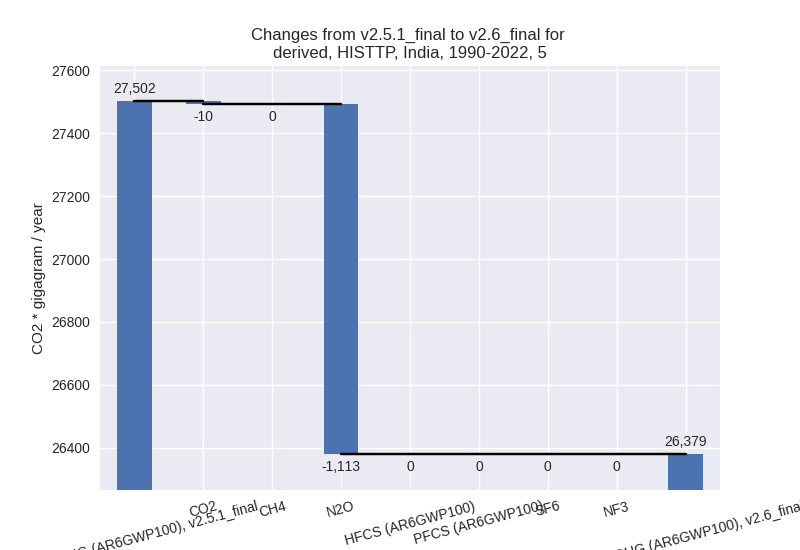Changes in PRIMAP-hist v2.6_final compared to v2.5.1_final for India
2024-09-24
Johannes Gütschow
Change analysis for India for PRIMAP-hist v2.6_final compared to v2.5.1_final
Overview over emissions by sector and gas
The following figures show the aggregate national total emissions excluding LULUCF AR6GWP100 for the country reported priority scenario. The dotted linesshow the v2.5.1_final data.
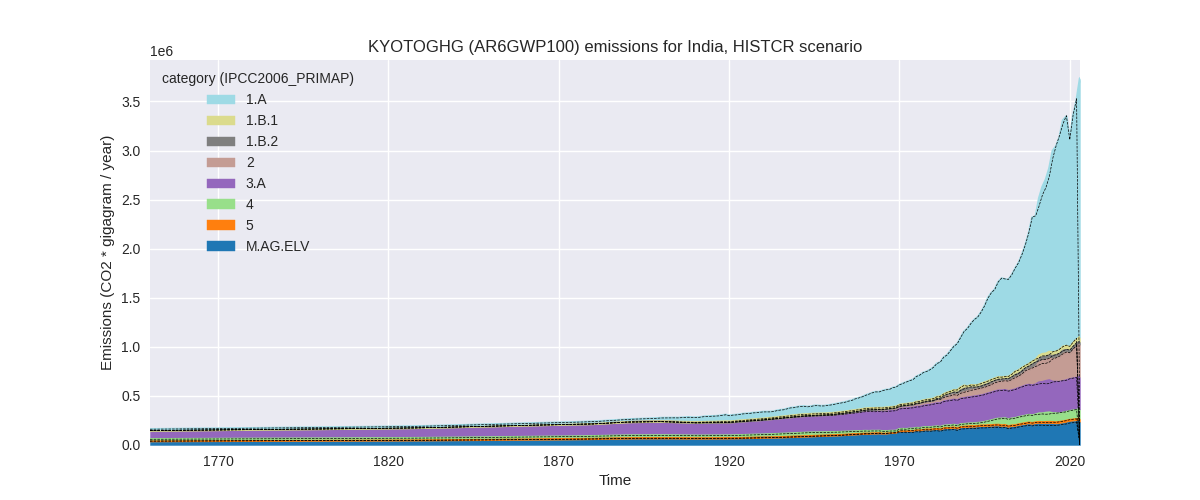
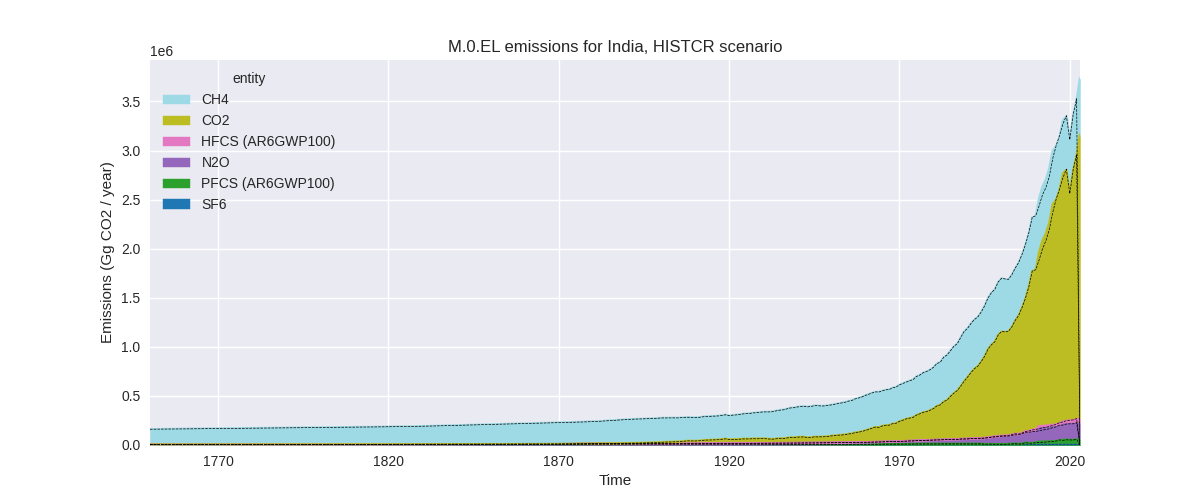
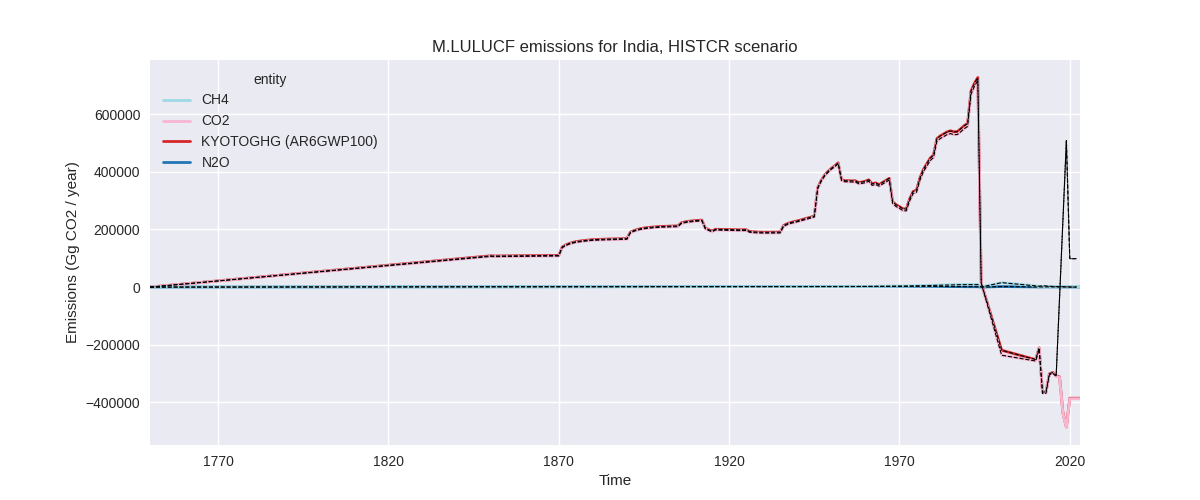
The following figures show the aggregate national total emissions excluding LULUCF AR6GWP100 for the third party priority scenario. The dotted linesshow the v2.5.1_final data.
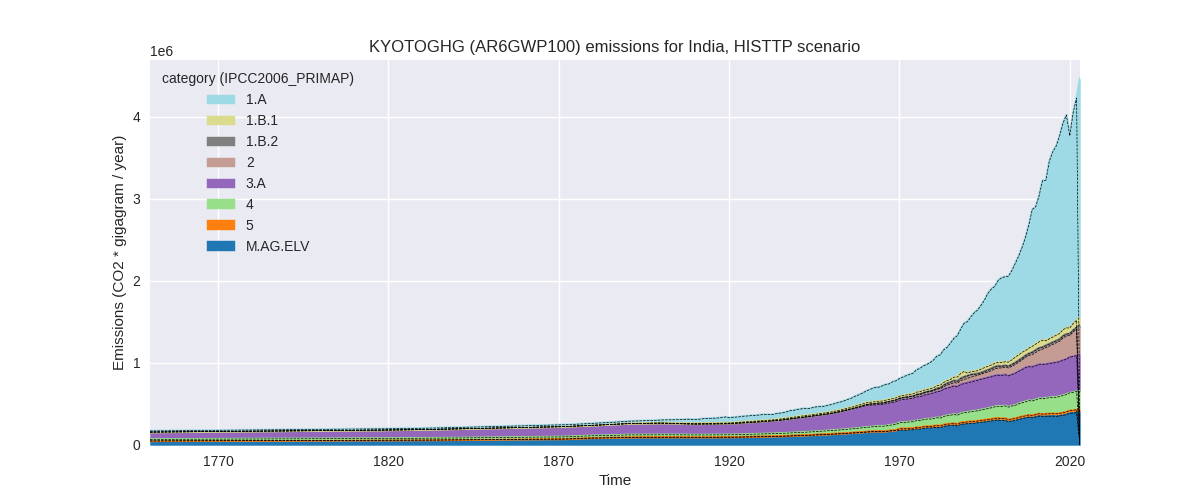
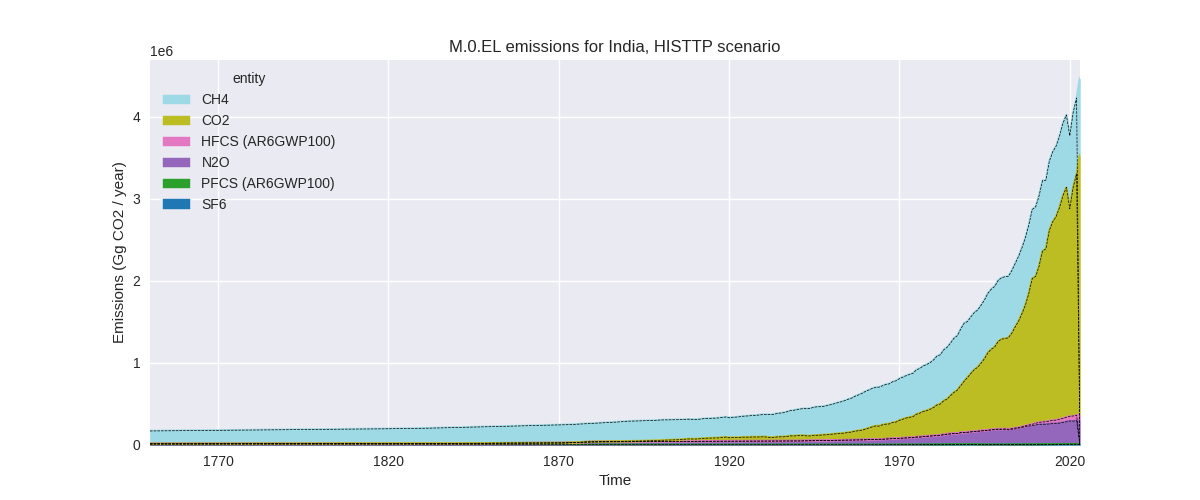
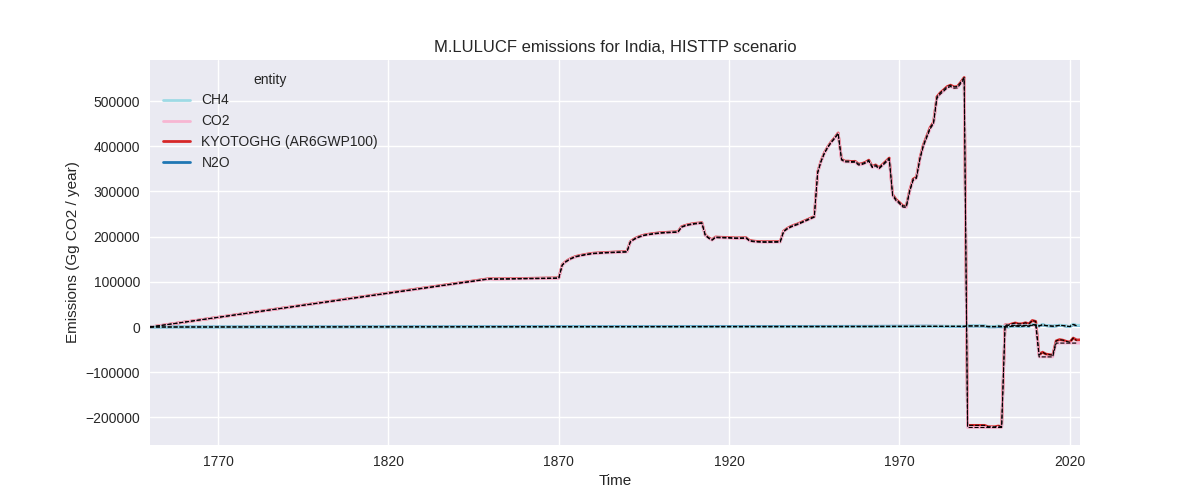
Overview over changes
In the country reported priority scenario we have the following changes for aggregate Kyoto GHG and national total emissions excluding LULUCF (M.0.EL):
- Emissions in 2022 have changed by -0.6%% (-19567.60 Gg CO2 / year)
- Emissions in 1990-2022 have changed by 0.4%% (8864.79 Gg CO2 / year)
In the third party priority scenario we have the following changes for aggregate Kyoto GHG and national total emissions excluding LULUCF (M.0.EL):
- Emissions in 2022 have changed by -0.3%% (-10665.00 Gg CO2 / year)
- Emissions in 1990-2022 have changed by -0.0%% (-305.22 Gg CO2 / year)
Most important changes per scenario and time frame
In the country reported priority scenario the following sector-gas combinations have the highest absolute impact on national total KyotoGHG (AR6GWP100) emissions in 2022 (top 5):
- 1: 2, CO2 with -6402.08 Gg CO2 / year (-3.0%)
- 2: 1.A, CO2 with -4596.80 Gg CO2 / year (-0.2%)
- 3: 5, N2O with -4576.28 Gg CO2 / year (-22.1%)
- 4: 2, PFCS (AR6GWP100) with -4128.32 Gg CO2 / year (-7.1%)
- 5: 2, HFCS (AR6GWP100) with 1106.43 Gg CO2 / year (2.6%)
In the country reported priority scenario the following sector-gas combinations have the highest absolute impact on national total KyotoGHG (AR6GWP100) emissions in 1990-2022 (top 5):
- 1: 1.A, CO2 with 10273.04 Gg CO2 / year (0.8%)
- 2: 2, CO2 with -2441.07 Gg CO2 / year (-2.1%)
- 3: 3.A, N2O with 1711.26 Gg CO2 / year (27.0%)
- 4: 5, N2O with -1112.87 Gg CO2 / year (-9.2%)
- 5: 4, CH4 with 515.66 Gg CO2 / year (0.9%)
In the third party priority scenario the following sector-gas combinations have the highest absolute impact on national total KyotoGHG (AR6GWP100) emissions in 2022 (top 5):
- 1: 1.A, CO2 with -5025.50 Gg CO2 / year (-0.2%)
- 2: 5, N2O with -4576.28 Gg CO2 / year (-22.1%)
- 3: 2, CO2 with -2967.44 Gg CO2 / year (-1.2%)
- 4: 4, N2O with 1118.94 Gg CO2 / year (7.0%)
- 5: 4, CH4 with 995.86 Gg CO2 / year (0.5%)
In the third party priority scenario the following sector-gas combinations have the highest absolute impact on national total KyotoGHG (AR6GWP100) emissions in 1990-2022 (top 5):
- 1: 2, CO2 with -1217.35 Gg CO2 / year (-1.0%)
- 2: 4, CH4 with 1215.06 Gg CO2 / year (0.8%)
- 3: 5, N2O with -1112.87 Gg CO2 / year (-9.2%)
- 4: 4, N2O with 800.67 Gg CO2 / year (6.9%)
- 5: 1.A, CO2 with -133.06 Gg CO2 / year (-0.0%)
Notes on data changes
Here we list notes explaining important emissions changes for the country. ’' means that the following text only applies to the TP time series, while means that it only applies to the CR scenario. Otherwise the note applies to both scenarios.
- We have fully included data from NC3 for 2011-2015 and 2017-2019. Data for 1994, 2000, 2010, and 2016 are taken from the UNFCCCDI. NC3 data for all years except 2019 needs downscaling where we use 2019 data and UNFCCCDI data as keys.
- Overall changes are small (< 1%), but individual sector changes are larger for some sectors.
- Changes are mostly in 2011-2015 and 2017-2018.
Changes by sector and gas
For each scenario and time frame the changes are displayed for all individual sectors and all individual gases. In the sector plot we use aggregate Kyoto GHGs in AR6GWP100. In the gas plot we usenational total emissions without LULUCF. ## country reported scenario
2022
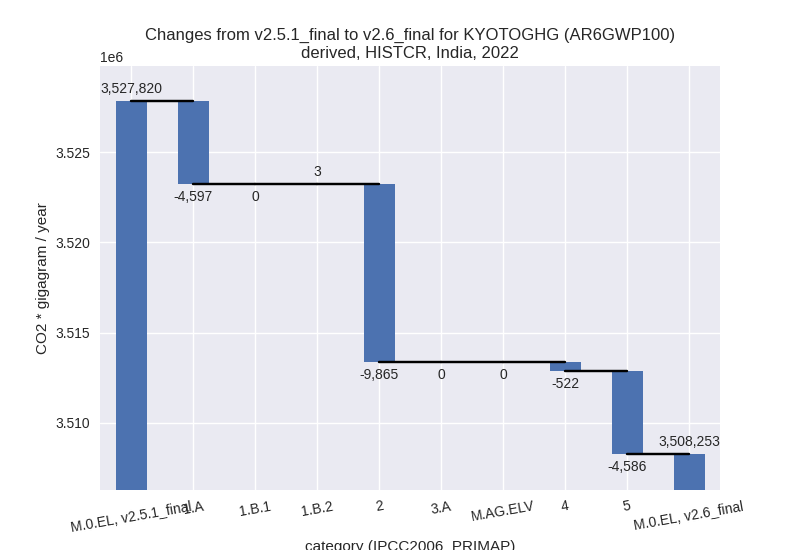
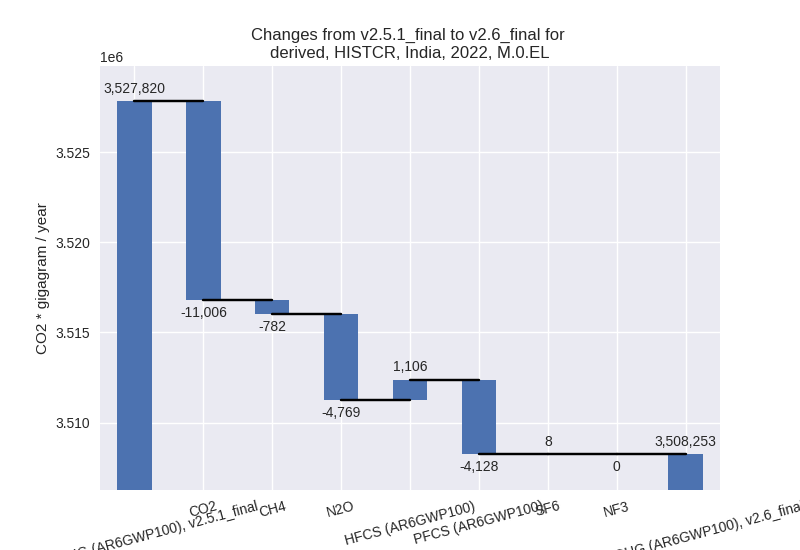
1990-2022
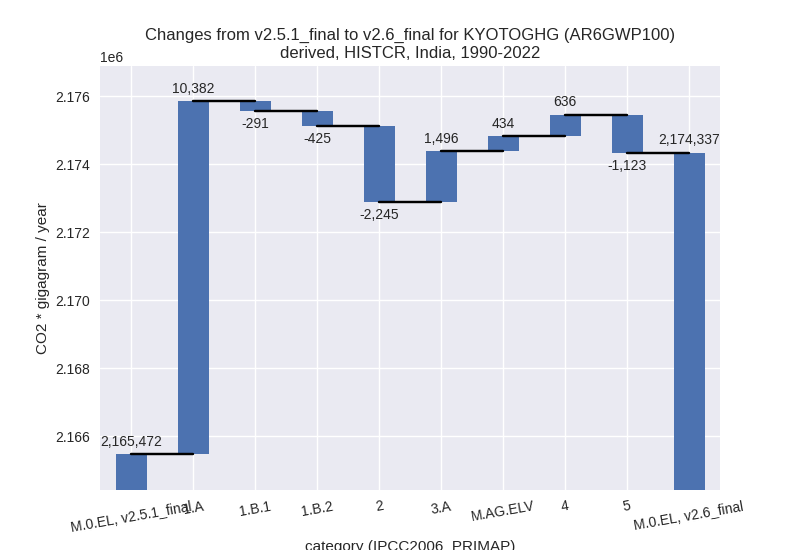
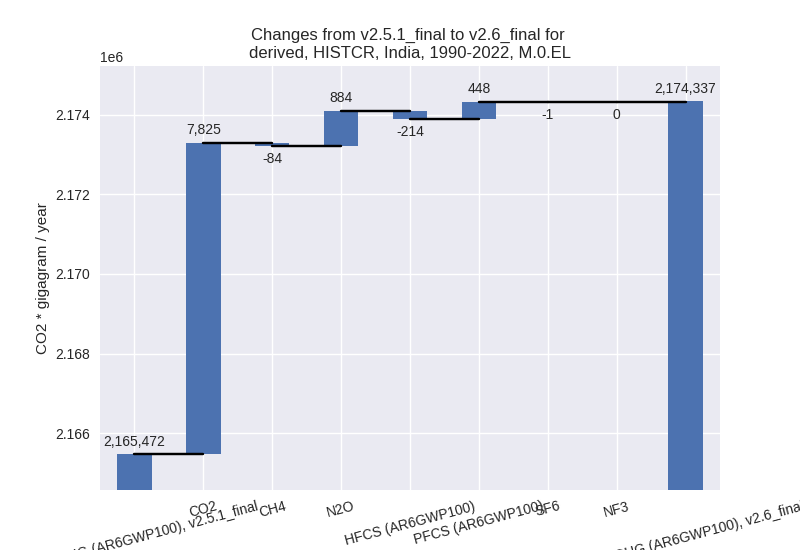
third party scenario
2022
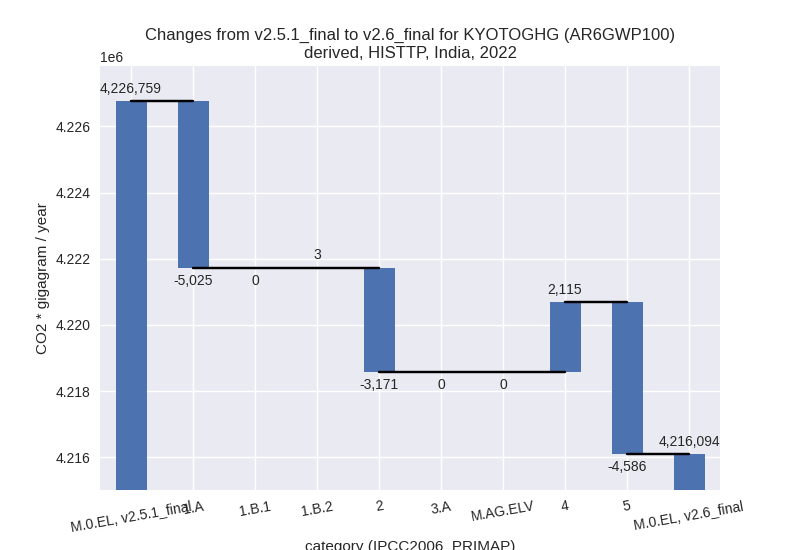
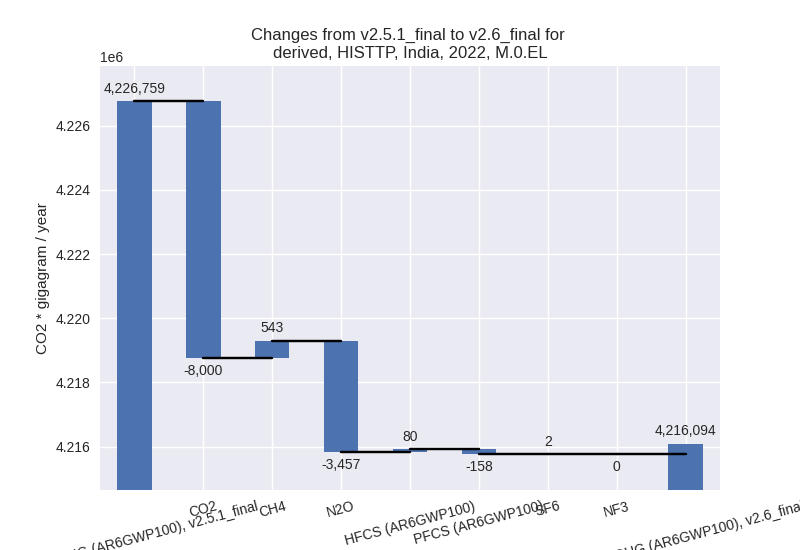
1990-2022

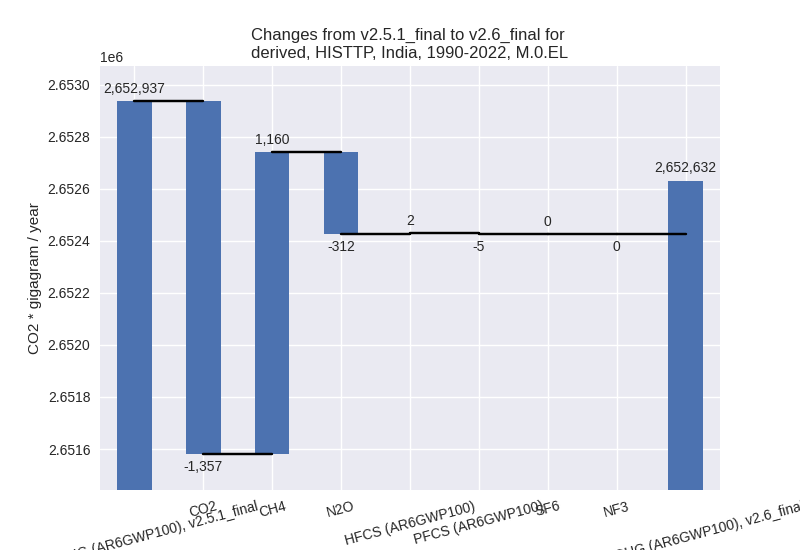
Detailed changes for the scenarios:
country reported scenario (HISTCR):
Most important changes per time frame
For 2022 the following sector-gas combinations have the highest absolute impact on national total KyotoGHG (AR6GWP100) emissions in 2022 (top 5):
- 1: 2, CO2 with -6402.08 Gg CO2 / year (-3.0%)
- 2: 1.A, CO2 with -4596.80 Gg CO2 / year (-0.2%)
- 3: 5, N2O with -4576.28 Gg CO2 / year (-22.1%)
- 4: 2, PFCS (AR6GWP100) with -4128.32 Gg CO2 / year (-7.1%)
- 5: 2, HFCS (AR6GWP100) with 1106.43 Gg CO2 / year (2.6%)
For 1990-2022 the following sector-gas combinations have the highest absolute impact on national total KyotoGHG (AR6GWP100) emissions in 1990-2022 (top 5):
- 1: 1.A, CO2 with 10273.04 Gg CO2 / year (0.8%)
- 2: 2, CO2 with -2441.07 Gg CO2 / year (-2.1%)
- 3: 3.A, N2O with 1711.26 Gg CO2 / year (27.0%)
- 4: 5, N2O with -1112.87 Gg CO2 / year (-9.2%)
- 5: 4, CH4 with 515.66 Gg CO2 / year (0.9%)
Changes in the main sectors for aggregate KyotoGHG (AR6GWP100) are
- 1: Total sectoral emissions in 2022 are 2510533.90 Gg CO2 / year which is 71.6% of M.0.EL emissions. 2022 Emissions have changed by -0.2% (-4594.10 Gg CO2 / year). 1990-2022 Emissions have changed by 0.7% (9665.80 Gg CO2 / year).
- 2: Total sectoral emissions in 2022 are 314834.18
Gg CO2 / year which is 9.0% of M.0.EL emissions. 2022 Emissions have
changed by -3.0% (-9865.44 Gg CO2 /
year). 1990-2022 Emissions have changed by -1.4% (-2244.76 Gg CO2 / year). For 2022
the changes per gas
are:
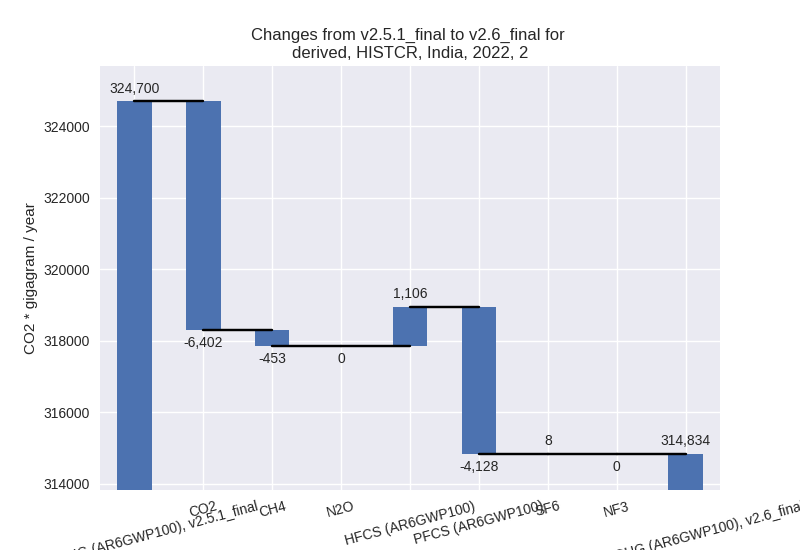
- M.AG: Total sectoral emissions in 2022 are 557420.23 Gg CO2 / year which is 15.9% of M.0.EL emissions. 2022 Emissions have changed by 0.0% (0.00 Gg CO2 / year). 1990-2022 Emissions have changed by 0.4% (1930.19 Gg CO2 / year).
- 4: Total sectoral emissions in 2022 are 93900.43 Gg CO2 / year which is 2.7% of M.0.EL emissions. 2022 Emissions have changed by -0.6% (-521.76 Gg CO2 / year). 1990-2022 Emissions have changed by 0.9% (636.44 Gg CO2 / year).
- 5: Total sectoral emissions in 2022 are 31563.91 Gg
CO2 / year which is 0.9% of M.0.EL emissions. 2022 Emissions have
changed by -12.7% (-4586.28 Gg CO2 /
year). 1990-2022 Emissions have changed by -4.1% (-1122.87 Gg CO2 / year). For 2022
the changes per gas
are:
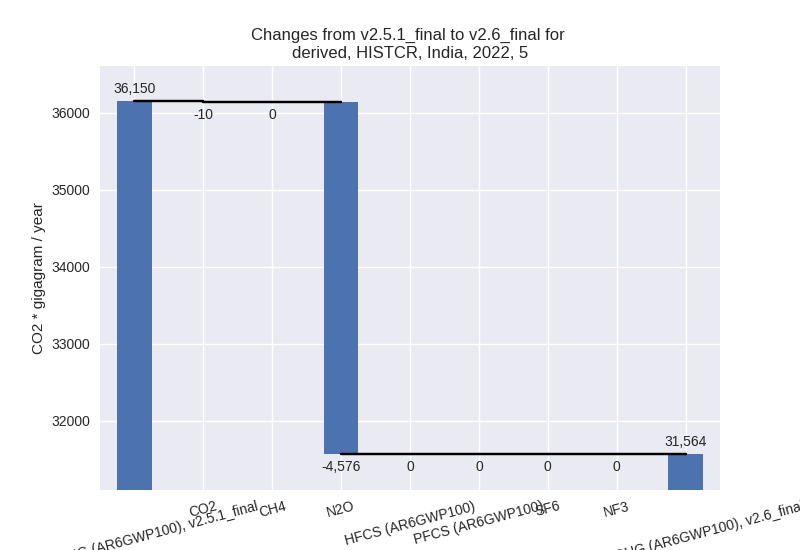
For 1990-2022 the changes per gas are: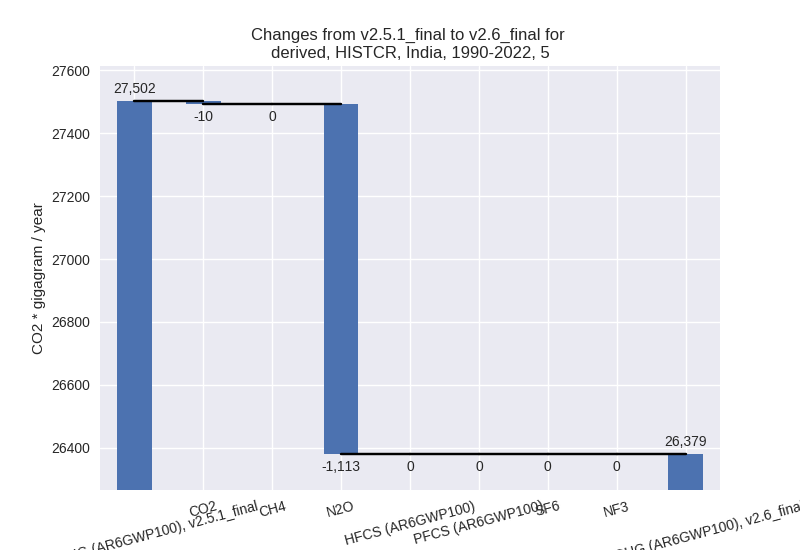
third party scenario (HISTTP):
Most important changes per time frame
For 2022 the following sector-gas combinations have the highest absolute impact on national total KyotoGHG (AR6GWP100) emissions in 2022 (top 5):
- 1: 1.A, CO2 with -5025.50 Gg CO2 / year (-0.2%)
- 2: 5, N2O with -4576.28 Gg CO2 / year (-22.1%)
- 3: 2, CO2 with -2967.44 Gg CO2 / year (-1.2%)
- 4: 4, N2O with 1118.94 Gg CO2 / year (7.0%)
- 5: 4, CH4 with 995.86 Gg CO2 / year (0.5%)
For 1990-2022 the following sector-gas combinations have the highest absolute impact on national total KyotoGHG (AR6GWP100) emissions in 1990-2022 (top 5):
- 1: 2, CO2 with -1217.35 Gg CO2 / year (-1.0%)
- 2: 4, CH4 with 1215.06 Gg CO2 / year (0.8%)
- 3: 5, N2O with -1112.87 Gg CO2 / year (-9.2%)
- 4: 4, N2O with 800.67 Gg CO2 / year (6.9%)
- 5: 1.A, CO2 with -133.06 Gg CO2 / year (-0.0%)
Changes in the main sectors for aggregate KyotoGHG (AR6GWP100) are
- 1: Total sectoral emissions in 2022 are 2811346.20 Gg CO2 / year which is 66.7% of M.0.EL emissions. 2022 Emissions have changed by -0.2% (-5022.80 Gg CO2 / year). 1990-2022 Emissions have changed by -0.0% (-129.73 Gg CO2 / year).
- 2: Total sectoral emissions in 2022 are 317423.36 Gg CO2 / year which is 7.5% of M.0.EL emissions. 2022 Emissions have changed by -1.0% (-3170.74 Gg CO2 / year). 1990-2022 Emissions have changed by -0.7% (-1068.33 Gg CO2 / year).
- M.AG: Total sectoral emissions in 2022 are 831055.26 Gg CO2 / year which is 19.7% of M.0.EL emissions. 2022 Emissions have changed by 0.0% (0.00 Gg CO2 / year). 1990-2022 Emissions have changed by 0.0% (0.00 Gg CO2 / year).
- 4: Total sectoral emissions in 2022 are 224705.03 Gg CO2 / year which is 5.3% of M.0.EL emissions. 2022 Emissions have changed by 1.0% (2114.80 Gg CO2 / year). 1990-2022 Emissions have changed by 1.2% (2015.73 Gg CO2 / year).
- 5: Total sectoral emissions in 2022 are 31563.91 Gg
CO2 / year which is 0.7% of M.0.EL emissions. 2022 Emissions have
changed by -12.7% (-4586.28 Gg CO2 /
year). 1990-2022 Emissions have changed by -4.1% (-1122.87 Gg CO2 / year). For 2022
the changes per gas
are:
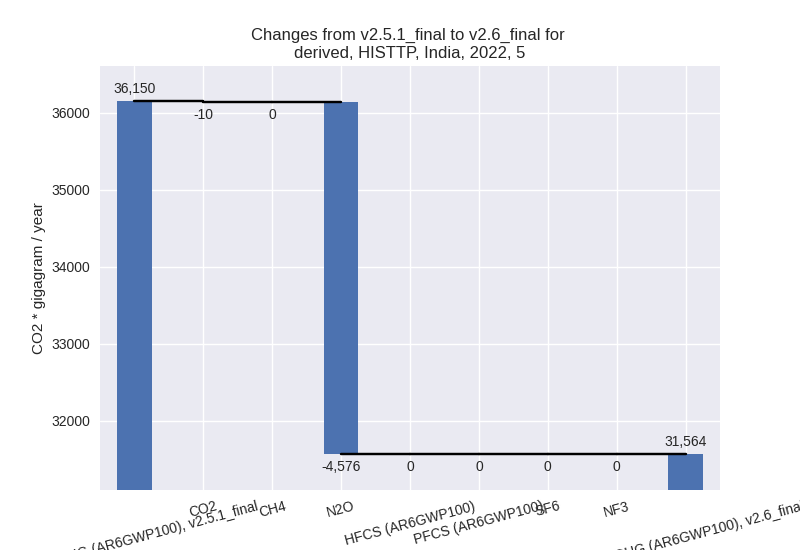
For 1990-2022 the changes per gas are: